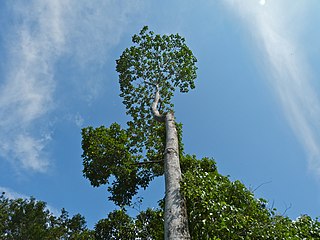
Averrhoa bilimbi is a fruit-bearing tree of the genus Averrhoa, family Oxalidaceae.

Ziziphus mauritiana, also known as Indian jujube, Indian plum, Chinese date, Chinese apple, and dunks is a tropical fruit tree species belonging to the family Rhamnaceae. It is often confused with the closely related Chinese jujube, but whereas Z. jujuba prefers temperate climates, Z. mauritiana is tropical to subtropical.

Mangifera caesia is a species of flowering plant in the cashew family, Anacardiaceae. Common names include jack, white mango, binjai, wani, yaa-lam, bayuno/baluno/belunok and mangga wani. It belongs to the same genus as the mango and is widely cultivated in areas of Indonesia, Malaysia, Singapore, Brunei, Papua New Guinea and the Philippines.

Nepenthes campanulata, the bell-shaped pitcher-plant, is a tropical pitcher plant native to Borneo. It has also been reported from Palawan, the Philippines, though further field work is needed to confirm this identification.

Eusideroxylon is a genus of evergreen trees of the family Lauraceae. The genus is possibly monotypic; it includes one accepted species and one that is "unresolved". It is present in coastal and montane rainforests of Southeast Asia, and in laurel forest habitat. Eusideroxylon are hardwood trees reaching up to 50 metres in height with trunks over 2 metres in diameter, producing commercially valuable timber. The wood of E. zwageri is impervious to termites, and can last up to 100 years after being cut. Due to extensive logging, it is listed as vulnerable in the IUCN Red List of IUCN, and conservation efforts are underway, with several countries banning imports.
Durio kinabaluensis, also known as mountain durian and (locally) as durian tapuloh, is a forest tree in the mallow family.
Durio crassipes, also known as durian hutan, is a species of flowering plant in the mallow family that is endemic to Borneo.
Bouea oppositifolia, also known as plum mango, kundang, kundangan or remenia, is a species of flowering plant, a fruit tree in the mango family, that is native to Indochina and Southeast Asia.
Mangifera griffithii is a species of flowering plant, a fruit tree in the mango family, that is native to Southeast Asia.
Mangifera torquenda is a species of flowering plant, a fruit tree in the mango family, that is native to Southeast Asia.
Willughbeia angustifolia is a species of flowering plant, a woody monoecious vine in the dogbane family, that is native to Southeast Asia.
Garcinia microcarpa, also known as kandis hutan, is a species of flowering plant, a dioecious understorey fruit tree in the mangosteen family, that is native to Southeast Asia.
Garcinia nitida, also known as kandis hutan, is a species of flowering plant, a dioecious understorey fruit tree in the mangosteen family, that is native to Southeast Asia.

Molineria latifolia, also known as tambaka, lamba and lemba babi, is a species of flowering plant, a stemless perennial herb in the Hypoxidaceae family, that is native to Southeast Asia and produces edible fruits.
Microcos crassifolia, also known locally as chanderai or bunsi, is a species of flowering plant, a fruit tree in the mallow family, that is endemic to Borneo.

Artocarpus lanceifolius, also known as keledang in Malay and more locally as timakon or kaliput, is a species of flowering plant, a fruit tree in the fig family, that is native to Southeast Asia.
Prainea limpato, also known as tampang susu in Malay and more locally as kesusu or empatak, is a species of flowering plant, a fruit tree in the fig family, that is native to Southeast Asia.

Artocarpus tamaran, also known as elephant jack in English, tarap tempunan in Malay, and more locally as timbangan, tamaran, entawa or wi yang, is a species of flowering plant, a fruit tree in the fig family, that is native to Southeast Asia.
Artocarpus teysmannii, also known as cempedak air in Malay and as tilap in Indonesia, is a species of flowering plant, a fruit tree in the fig family, that is native to Southeast Asia.
Ficus uncinata, also known as earth fig in English and as ara entimau in Iban, is a species of flowering plant, a fruit tree in the fig family, that is native to Southeast Asia.







